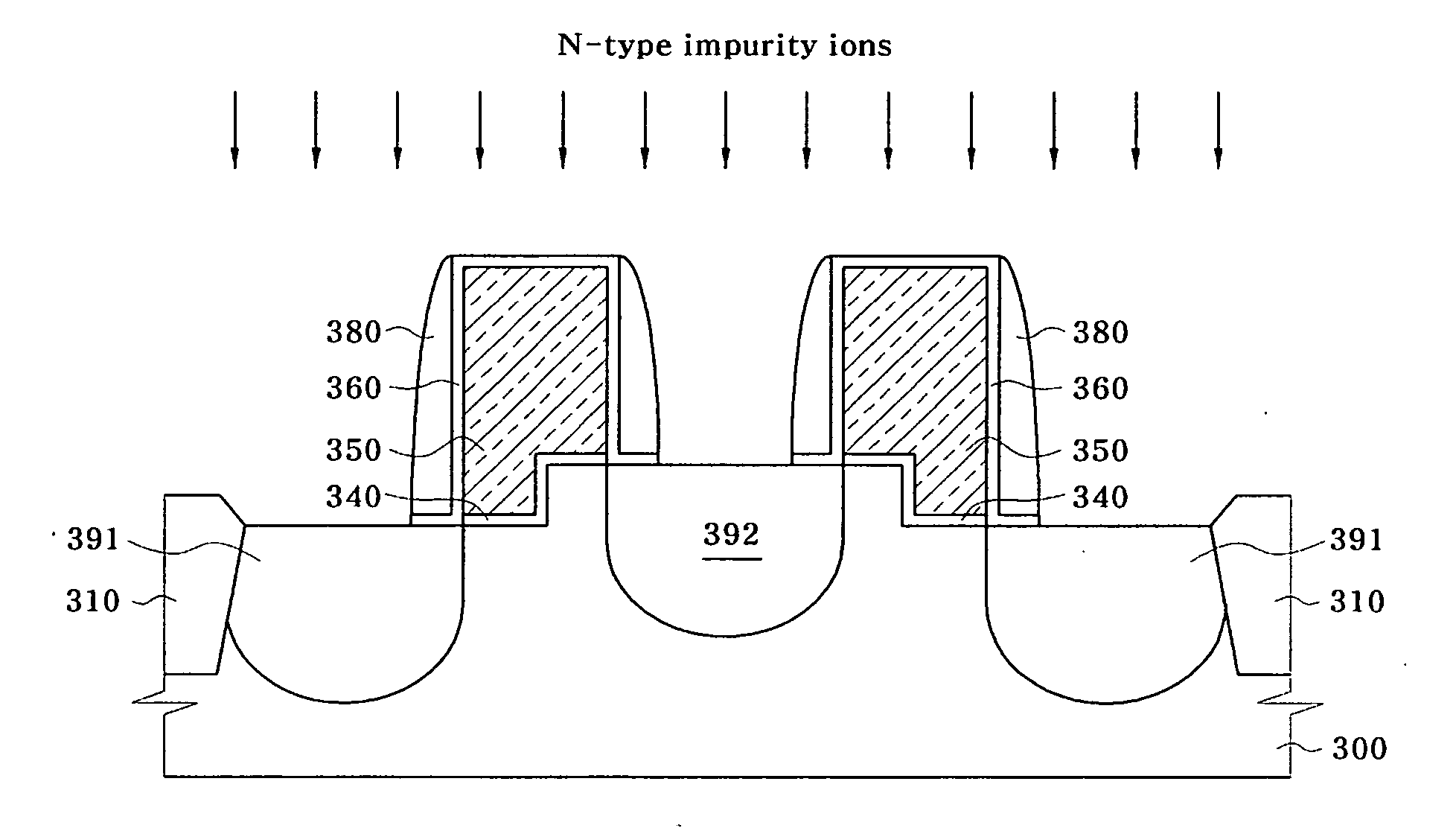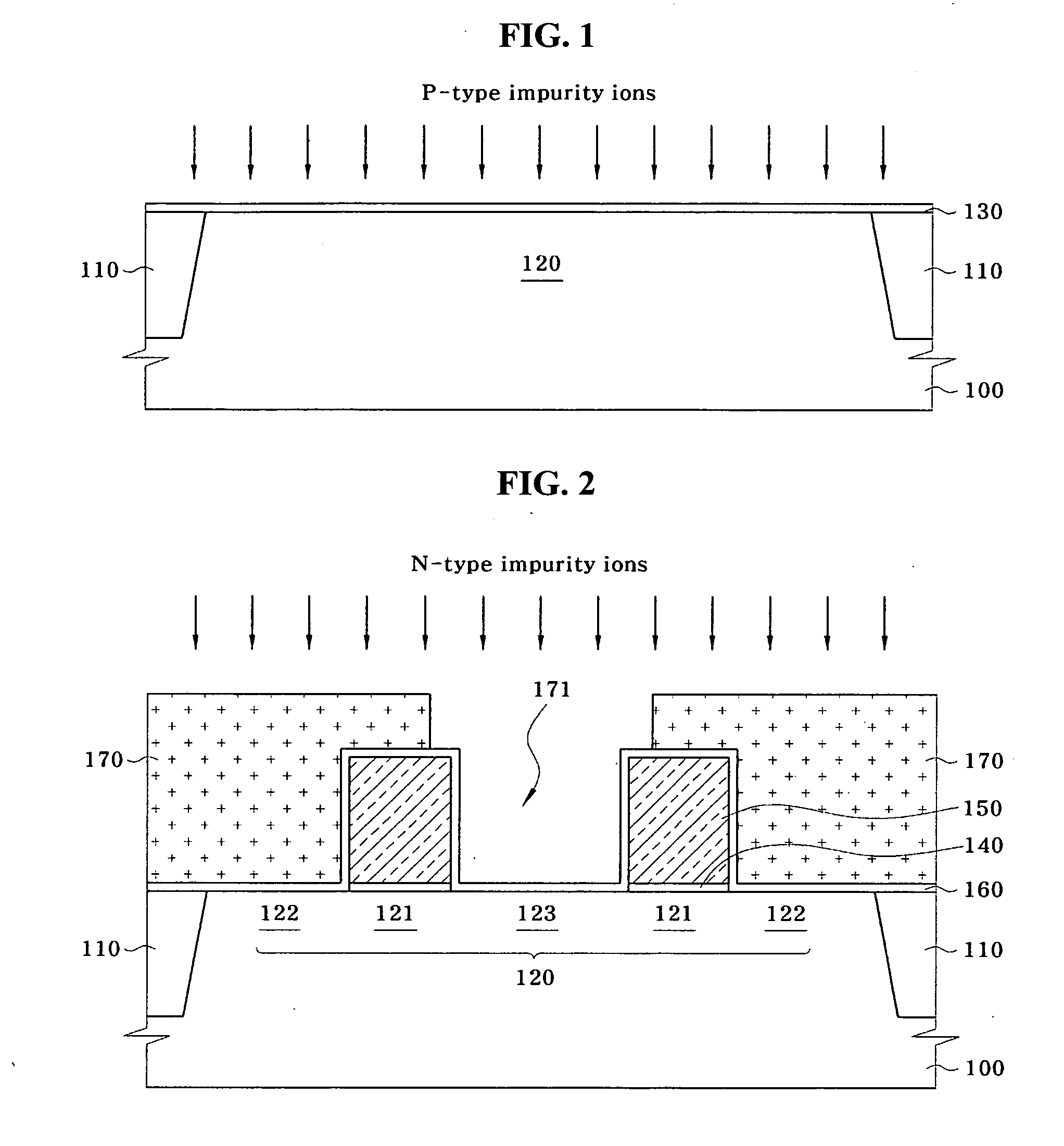Method for manufacturing semiconductor memory device using asymmetric junction ion implantation
a semiconductor memory and asymmetric junction technology, applied in the direction of semiconductor devices, basic electric elements, electrical appliances, etc., can solve the problems of deteriorating device operating characteristics and stability, and deteriorating device refresh characteristics, so as to prolong data retention time and improve refresh characteristics
- Summary
- Abstract
- Description
- Claims
- Application Information
AI Technical Summary
Benefits of technology
Problems solved by technology
Method used
Image
Examples
first embodiment
[0054] FIGS. 1 to 4 are cross-sectional views illustrating a method for manufacturing a semiconductor memory device in accordance with the invention. In this embodiment, the method can be applied to a semiconductor memory device having a planar structure.
[0055] Referring to FIG. 1, an active region 120 is defined by forming isolation layers 110 on a semiconductor substrate 100. Then, a buffer insulation layer 130 is formed of an oxide layer on the semiconductor substrate 100 having the active region 120 defined thereon. Next, as indicated by arrows in FIG. 1, ion implantation for channel threshold voltage is performed on an overall surface of the semiconductor substrate 100. This embodiment will be described using an n-type channel as an example. Accordingly, p-type impurity ions are implanted to an upper portion of the semiconductor substrate 100 by the ion implantation for channel threshold voltage. The p-type impurity ions are implanted in a concentration about 70% of an entire c...
second embodiment
[0062] Now referring to FIG. 5, an active region is defined by forming isolation layers 210 on a semiconductor substrate 200. Then, trenches 201 and 202 for a recess channel are formed by etching a portion of the active region on the semiconductor substrate 200 by a predetermined depth. As the trenches 201 and 202 for the recess channel are formed, the active region of the semiconductor substrate is defined with a channel region formed along the trenches 201 and 202 for the recess channel, a storage node junction region 122, and a bit line junction region 123. Then, a buffer insulation layer 230 is formed of an oxide layer on the semiconductor substrate 200 having the trenches 201 and 202 for the recess channel formed thereon. In some cases, a natural oxide layer may be used as the buffer insulation layer 230. Next, as indicated by arrows in FIG. 5, ion implantation for channel threshold voltage is performed on the overall surface of the semiconductor substrate 200. The second embod...
third embodiment
[0069] Now referring to FIG. 9, an active region is defined by forming isolation layers 310 on a semiconductor substrate 300. Then, a step profile is formed by etching a portion of the active region on the semiconductor substrate 300 by a predetermined depth. Then, as indicated by arrows in FIG. 9, ion implantation for channel threshold voltage is performed on an overall surface of the semiconductor substrate 300 having the step profile formed thereon. Although not shown in the drawing, a natural oxide layer or an additional buffer insulation layer may be disposed on the semiconductor substrate 300. The third embodiment will also be described using an n-type channel as an example. Accordingly, p-type impurity ions are implanted to an upper portion of the semiconductor substrate 300 by the ion implantation for channel threshold voltage. The p-type impurity ions are implanted in a concentration about 70% of an entire channel concentration.
[0070] Referring to FIG. 10, a gate insulation...
PUM
 Login to View More
Login to View More Abstract
Description
Claims
Application Information
 Login to View More
Login to View More - R&D
- Intellectual Property
- Life Sciences
- Materials
- Tech Scout
- Unparalleled Data Quality
- Higher Quality Content
- 60% Fewer Hallucinations
Browse by: Latest US Patents, China's latest patents, Technical Efficacy Thesaurus, Application Domain, Technology Topic, Popular Technical Reports.
© 2025 PatSnap. All rights reserved.Legal|Privacy policy|Modern Slavery Act Transparency Statement|Sitemap|About US| Contact US: help@patsnap.com



